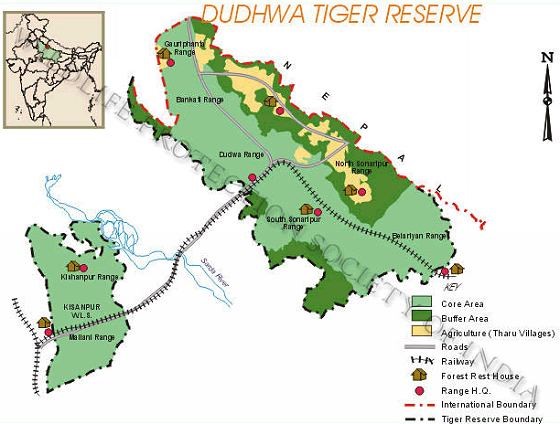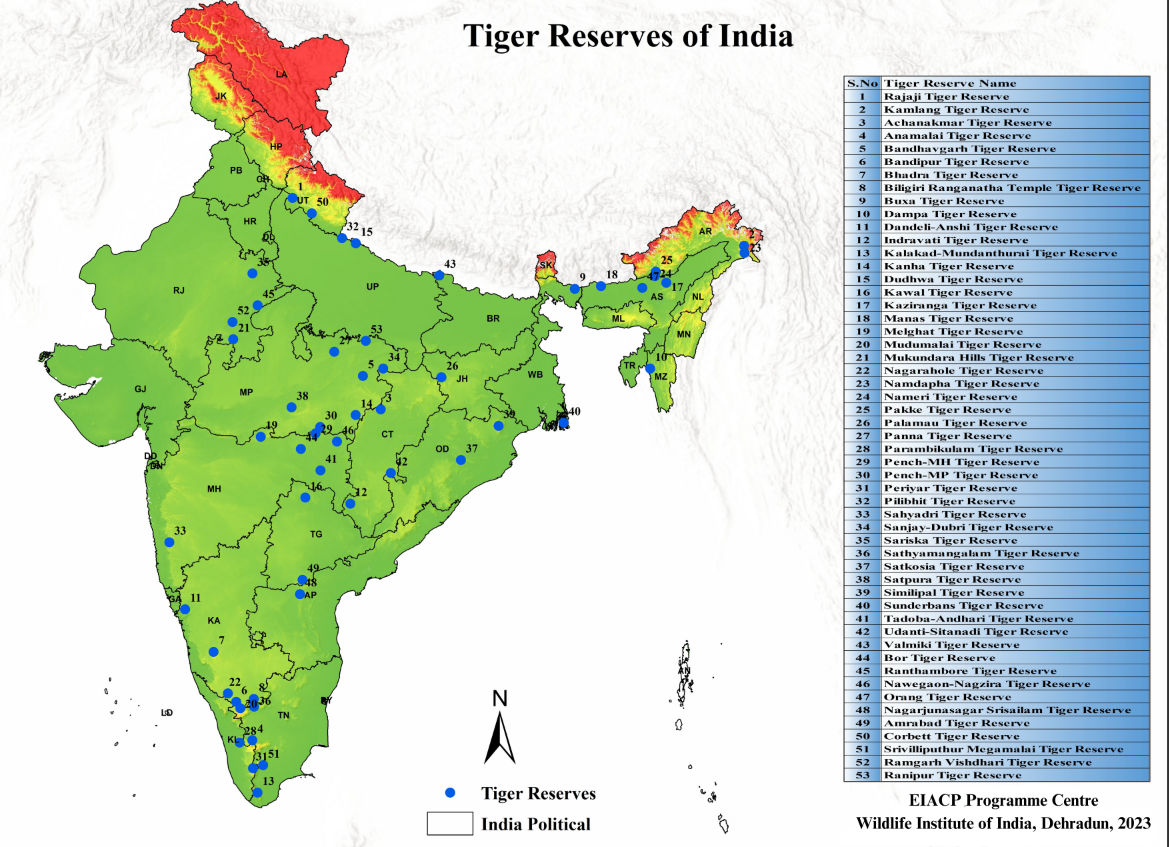Description

Disclaimer: Copyright infringement not intended.
Context
- A dead body of two-year-old tigress was found in the buffer zone of the Dudhwa Tiger Reserve.
- Ruling out the possibilities of poisoning or poaching, the probable reason for its death is considered to be its inability to hunt or move properly which subsequently led to its death.
- To ascertain the cause of death the carcass is being sent to the Indian Veterinary Research Institute, Bareilly for postmortem examination.
About Dudhwa Tiger Reserve
- It is a protected area, located in Terai region of Uttar Pradesh near the India and Nepal border, spreading in the districts of Lakhimpur Kheri and Bahraich.
- This park is recognized for its eco-tourism initiatives with an aim to promote sustainable tourism.
History
- In 1965 It was declared a Wildlife Sanctuary.
- In 1977 It was established as a National park.
- As a part of project Tiger, It was declared a tiger reserve in 1987-88 as it has a significant population of Bengal tigers.
- Dudhwa Tiger Reserve includes the areas of Dudhwa National Parks along with Kishanpur and Katarniaghat wildlife sanctuary and has a total area of 2,201.77 square Km which includes a buffer area of 1,107.98.
- It consists of wetlands, Marshes, dense forests, rivers and streams etc.
Flora
- It shows a characteristics of tropical semi-evergreen forest, northern Indian moist deciduous forest, and tropical seasonal swamp forest.
- It includes Grasslands, sal, asna, shisham, jamun, gular, sehore and bahera.
Fauna
- Apart from tigers there exists variety of fauna which includes elephants, sloth bears, northern swamp deer, one horned Rhinoceros, Hispid Hare
- There are over 450 species of birds like Asian king vulture (Sarcogyps calvus) -a critically-endangered species.

Disclaimer: Copyright infringement not intended.
Project Tiger and Tiger Reserves in India
- Project Tiger was launched by the Government of India in the year 1973 to save the endangered species of tiger in the country in their natural habitat.
- National Tiger Conservation Authority provides statutory authority to Project Tiger for legal compliance of its directives.
- The government declared the tiger India's national animal and banned hunting of tigers.
- There are a total of 53 tiger reserves in country.
- Largest Tiger Reserve (in terms of core area) is Nagarjuna Sirsailam Tiger Reserve, (Andhra Pradesh).
- Smallest Tiger Reserve (in terms of core area) is Orang National Park, (Assam).
- Amangarh Tiger Reserve, Uttar Pradesh is a buffer zone of Jim Corbett National Park, Uttarakhand and may not be regarded as a separate tiger reserve.

Protection status of Tiger
- IUCN status of tiger is Endangered.
- In 2005 The National Tiger Conservation Authority (NTCA) has been constituted, to further the cause of tiger protection.
- It provides statutory authority to Project Tiger for legal compliance of its directives.
- Protected in Schedule 1 of Indian wildlife protection Act 1992, which makes it mandatory for a state government to establish a Tiger conservation foundation within a state in each Tiger Reserve. The main aim is to facilitate and support of conservation of tigers.
- For violation of the law under this Schedule, there is a provision for penalty.
|
National Tiger Conservation Authority
It has been constituted under section 38 L (1) of Wildlife (Protection) Act, 1972. Further, as per the section 38 L, sub section 2 of the said Act.
Chairperson - Minister of the Ministry of Environment, Forests and climate change
Vice-Chairperson - The Minister of State in the Ministry of Environment and Forests
Also included three members of Parliament, Secretary, Ministry of Environment and Forests and other members.
The authority derives its power from section 38 O (1) of WLPA, 1972 and functions under the guidance of Chairperson, Vice-Chairperson and members..
|
|
PRACTICE QUESTION
Protection of tigers is necessary with regards to the viability of ecosystem. Substantiate. Also mention the measure taken to protect the tigers in India. (250 words)
|

https://indianexpress.com/article/india/up-tigress-found-dead-dudhwa-buffer-zone-lakhimpur-kheri-8644186/
https://en.wikipedia.org/wiki/Dudhwa_National_Park
https://www.hindustantimes.com/cities/others/criticallyendangered-asian-king-vulture-sighted-in-dudhwa-101678902814752-amp.html
http://wiienvis.nic.in/Database/Tiger%20Reserves%20_8222.aspx
https://ntca.gov.in













